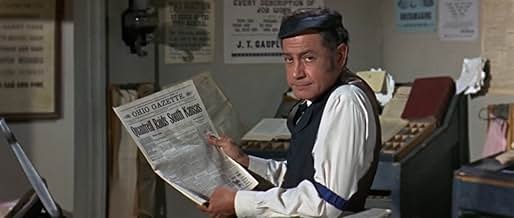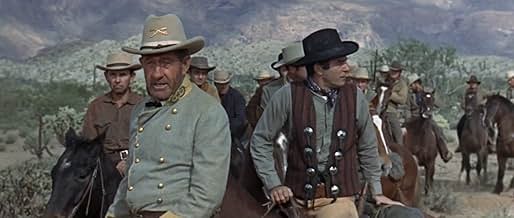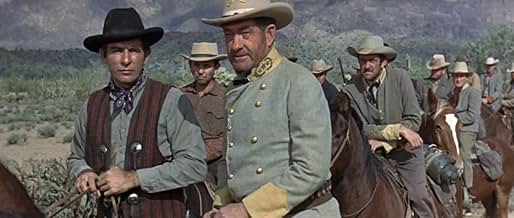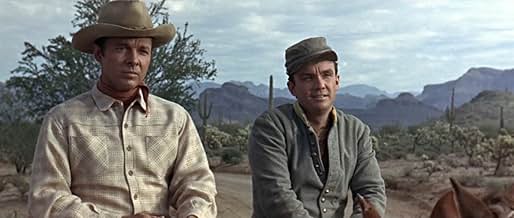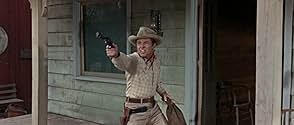IMDb RATING
5.9/10
1.3K
YOUR RATING
After Quantrell's gang is almost destroyed, two of the captured members agree to join the Arizona Rangers to help finish the job.After Quantrell's gang is almost destroyed, two of the captured members agree to join the Arizona Rangers to help finish the job.After Quantrell's gang is almost destroyed, two of the captured members agree to join the Arizona Rangers to help finish the job.
Willard W. Willingham
- Eddie
- (as Willard Willingham)
Boyd 'Red' Morgan
- Tex
- (as Red Morgan)
Booth Colman
- Ohio Gazette Editor
- (uncredited)
Robert Shelton
- Jim
- (uncredited)
Featured reviews
This movie is a remake of the 1951 movie "The Texas Rangers", same plot, same storyline, same lines. Only the locale and the actors are different. I take that back, this time it wasn't just a couple of men who were removed from prison, they were moved from state to state.
Having said that, I did enjoy the movie. There were enough changes to make it interesting. Audie Murphy did a wonderful job in the lead role. The location was beautiful. The director did a good job in making this movie stand on it's own.
If you liked the earlier movie, you will enjoy this remake. Audie Murphy fans should enjoy seeing him in this.
Having said that, I did enjoy the movie. There were enough changes to make it interesting. Audie Murphy did a wonderful job in the lead role. The location was beautiful. The director did a good job in making this movie stand on it's own.
If you liked the earlier movie, you will enjoy this remake. Audie Murphy fans should enjoy seeing him in this.
When the Quantrell gang is almost destroyed, two of its members, Clint (Audie Murphy) and Willie Martin (Ben Cooper), are taken prisoner, but they later escape from prison thanks to a captain (Buster Crabbe) who assigns them a dangerous mission, to become Arizona Rangers and hunt down the murderous members of their former band. They are rumored to be hiding in a town "near the border", according to the words of a ballroom dancer. So our protagonists head off to pursue the thugs - Brady (Michael Dante) and Montana (George Keymas) - who are allegedly hiding on an Indian mission. After a massacre, there they find a beautiful young Indian woman (Gloria Talbott), but then things go wrong.
In the period when European westerns were in vogue, the sixties, with Sergio Leone as the main architect, this western film from th was released on screens with relative success . The film is full of whirlwinds of action, confrontations, emotions, fights, sustained energy and, often, praiseworthy results. The feature film has a raw elegance and vigor, although some scenes are a failure. A tense but already seen plot allowed director William Witney to maintain scenes with pedigree and at their own gallop, as well as exciting and moving moments. The Indian attacks, the shootouts, the pyrotechnics, the duels, the horse chases, all of them are briefly spectacular due to the condition of being a low-budget film, that is why the film is another passable Hollywood product, but B-series. It contains some vigorous and cleverly done action scenes, but others do not make much sense. There's a surprising description about the Yaqui Indians that are described as somewhat wild natives who subject their enemies to cruel torture, such as the execution of the "Cactus." The film stars Audie Murphy, one of the most decorated American soldiers of World War II, who, after the conflict, turned to film actor, playing a soldier in the war in the movie "Return to Hell," as well as developing a brief career as a country musician. Here Murphy plays in his ordinary style a former follower of the well-known Quantrell who is escaped from prison with his friend Ben Cooper to become an agent of the Arizona Rangers in order to hunt down the remnants of the gang. He is accompanied by an aging Buster Crabbe, a former Olympic swimmer who in his youth successfully played three of the most popular comic book heroes of the 1930s: Tarzan (Tarzan of the Beasts), Flash Gordon (Flash Gordon Conquers the Universe) and Buck Rogers (Buck Rogers).
The film was professionally directed by William Witney, one of Tarantino's favorite filmmakers. In fact, he was the one who began choreographing the action scenes in Westerns, following the pattern used in Busby Berkeley's musicals. A prolific filmmaker, Witney was a craftsman who worked extensively for Republic Pictures, the studio where he worked for many years producing a series of low-budget Westerns, many of them starring singing cowboys like Roy Rogers and Gene Autry. Witney spent his entire career making serials and second-rate films, such as 40 Guns at Apache Pass as well as Apache Rifles. After World War II, William Witney continued acting in western films such as Shadows of Tombstone, Heart of Rockies, Bells of Coronado, The Painted Stallion, The Lone Ranger, Home in Oklahoma, On the Old Spanish Trail, High Time in Nevada, Gay Ranchero, Helldorado, Rex Ryder, Eyes of Texas, among others. In addition, his work in television included some quite interesting episodes of successful series, such as: High Chaparral, Bonanza, Laramie, Zorro, The Virginian, Wagon Train and he continued working in film and was able to make passable mid-budget films such as Santa Fe Passage, The Bonnie Parker story, Robur and Escaped from Devil Island. Score: 5.5/10. An acceptable and slightly decent western, at times, that Audie Murphy fans will love.
In the period when European westerns were in vogue, the sixties, with Sergio Leone as the main architect, this western film from th was released on screens with relative success . The film is full of whirlwinds of action, confrontations, emotions, fights, sustained energy and, often, praiseworthy results. The feature film has a raw elegance and vigor, although some scenes are a failure. A tense but already seen plot allowed director William Witney to maintain scenes with pedigree and at their own gallop, as well as exciting and moving moments. The Indian attacks, the shootouts, the pyrotechnics, the duels, the horse chases, all of them are briefly spectacular due to the condition of being a low-budget film, that is why the film is another passable Hollywood product, but B-series. It contains some vigorous and cleverly done action scenes, but others do not make much sense. There's a surprising description about the Yaqui Indians that are described as somewhat wild natives who subject their enemies to cruel torture, such as the execution of the "Cactus." The film stars Audie Murphy, one of the most decorated American soldiers of World War II, who, after the conflict, turned to film actor, playing a soldier in the war in the movie "Return to Hell," as well as developing a brief career as a country musician. Here Murphy plays in his ordinary style a former follower of the well-known Quantrell who is escaped from prison with his friend Ben Cooper to become an agent of the Arizona Rangers in order to hunt down the remnants of the gang. He is accompanied by an aging Buster Crabbe, a former Olympic swimmer who in his youth successfully played three of the most popular comic book heroes of the 1930s: Tarzan (Tarzan of the Beasts), Flash Gordon (Flash Gordon Conquers the Universe) and Buck Rogers (Buck Rogers).
The film was professionally directed by William Witney, one of Tarantino's favorite filmmakers. In fact, he was the one who began choreographing the action scenes in Westerns, following the pattern used in Busby Berkeley's musicals. A prolific filmmaker, Witney was a craftsman who worked extensively for Republic Pictures, the studio where he worked for many years producing a series of low-budget Westerns, many of them starring singing cowboys like Roy Rogers and Gene Autry. Witney spent his entire career making serials and second-rate films, such as 40 Guns at Apache Pass as well as Apache Rifles. After World War II, William Witney continued acting in western films such as Shadows of Tombstone, Heart of Rockies, Bells of Coronado, The Painted Stallion, The Lone Ranger, Home in Oklahoma, On the Old Spanish Trail, High Time in Nevada, Gay Ranchero, Helldorado, Rex Ryder, Eyes of Texas, among others. In addition, his work in television included some quite interesting episodes of successful series, such as: High Chaparral, Bonanza, Laramie, Zorro, The Virginian, Wagon Train and he continued working in film and was able to make passable mid-budget films such as Santa Fe Passage, The Bonnie Parker story, Robur and Escaped from Devil Island. Score: 5.5/10. An acceptable and slightly decent western, at times, that Audie Murphy fans will love.
At film's beginning Booth Colman, as editor of the Ohio Gazette, wastes seven minutes narrating the ruthlessness of William Quantrill, infamously known gang leader and Confederate sympathizer who murdered the adult male population of Lawrence Kansas. Since the first few active minutes of the movie do center on the Civil War brigand, one wonders why the narration persists for so long. Anyway, with the War over (1865), the story begins to move along smoothly as the Quantrill band continues to operate.
Union Captain Tom Andrews (Buster Crabbe) tracks down and corners Quantrill (Fred Graham) and his gang in an abandoned farmhouse/barn. Although some gang members escape, Quantrill is severely wounded and captured. He will eventually breathe his last in a Union hospital, and he will not be seen in the picture again. (By the way, Quantrill died in June 1865.) Meanwhile two gang members are captured, partially through the machinations of Montana Smith (George Keymas), a shady and disloyal gang member who escapes the Federal grasp. The two arrested ex-Confederate soldiers, Clint Stewart (Audie Murphy) and friend Willie Martin (Ben Cooper), served honorably for the Southern cause. But when they returned home at war's end they found that Carpetbaggers were in control. Since the two ex-troopers could not find work, they joined Quantrill's outfit. Though the sympathy of both Andrews and the presiding judge, the two receive lighter sentences than usual but still get 20 years hard labor in prison.
Escaping from the Federal troops, both Montana and Brady (Michael Dante) have reformed the Quantrill gang and are running roughshod in Arizona, where the post-Civil War law is not strong. Enter Andrews again, as he has been hired by the territorial governor to head up the newly formed Arizona Rangers. Andrews' mission is to capture the gang and bring it to justice. As Andrews is impressed with Stewart and Martin's background he makes a risky bargain with them: unconditional pardons and positions as Arizona Rangers if they infiltrate the gang and bring about its destruction. To make the situation legitimate, Andrews arranges for a fake-prison escape. The two ex-Rebels can flee to Mexico, but better judgment prevails and they go to work against Montana and Brady, who by this time have taken control of a Yaqui Indian village.
This rousing and colorful western features beautiful Arizona scenery. William Whitney directed a typical cowboy movie with some perky shoot-outs and ornery villains, especially Keymas' sadistic and vile Montana (By contrast, accomplice Brady is almost a church choir member). Fred Graham, who portrays Quantrill, was twice the age of the real outlaw, but his work here is sound. Murphy of course fits in well in a familiar role.
There were high quality westerns made in 1965, like "Major Dundee," "The Sons of Katie Elder," and the comedy-western "Cat Ballou." But it was a watershed year for the genre as times were a-changin'. In 1966 Burt Kennedy would direct "Welcome to Hard Times" (released in 1967). Also, westerns from Europe were making their arrivals in the USA. These films would alter the western and blur the distinction between the good guys and the bad ones. They kept the guns of the good guy, but took away most of his moral code. Alas, they created the anti-hero, a major influence of those westerns made in the late 1960s, 1970s, and 1980s.
(See my review for the watershed western "Welcome to Hard Times" dated 23 Nov 2011.)
Union Captain Tom Andrews (Buster Crabbe) tracks down and corners Quantrill (Fred Graham) and his gang in an abandoned farmhouse/barn. Although some gang members escape, Quantrill is severely wounded and captured. He will eventually breathe his last in a Union hospital, and he will not be seen in the picture again. (By the way, Quantrill died in June 1865.) Meanwhile two gang members are captured, partially through the machinations of Montana Smith (George Keymas), a shady and disloyal gang member who escapes the Federal grasp. The two arrested ex-Confederate soldiers, Clint Stewart (Audie Murphy) and friend Willie Martin (Ben Cooper), served honorably for the Southern cause. But when they returned home at war's end they found that Carpetbaggers were in control. Since the two ex-troopers could not find work, they joined Quantrill's outfit. Though the sympathy of both Andrews and the presiding judge, the two receive lighter sentences than usual but still get 20 years hard labor in prison.
Escaping from the Federal troops, both Montana and Brady (Michael Dante) have reformed the Quantrill gang and are running roughshod in Arizona, where the post-Civil War law is not strong. Enter Andrews again, as he has been hired by the territorial governor to head up the newly formed Arizona Rangers. Andrews' mission is to capture the gang and bring it to justice. As Andrews is impressed with Stewart and Martin's background he makes a risky bargain with them: unconditional pardons and positions as Arizona Rangers if they infiltrate the gang and bring about its destruction. To make the situation legitimate, Andrews arranges for a fake-prison escape. The two ex-Rebels can flee to Mexico, but better judgment prevails and they go to work against Montana and Brady, who by this time have taken control of a Yaqui Indian village.
This rousing and colorful western features beautiful Arizona scenery. William Whitney directed a typical cowboy movie with some perky shoot-outs and ornery villains, especially Keymas' sadistic and vile Montana (By contrast, accomplice Brady is almost a church choir member). Fred Graham, who portrays Quantrill, was twice the age of the real outlaw, but his work here is sound. Murphy of course fits in well in a familiar role.
There were high quality westerns made in 1965, like "Major Dundee," "The Sons of Katie Elder," and the comedy-western "Cat Ballou." But it was a watershed year for the genre as times were a-changin'. In 1966 Burt Kennedy would direct "Welcome to Hard Times" (released in 1967). Also, westerns from Europe were making their arrivals in the USA. These films would alter the western and blur the distinction between the good guys and the bad ones. They kept the guns of the good guy, but took away most of his moral code. Alas, they created the anti-hero, a major influence of those westerns made in the late 1960s, 1970s, and 1980s.
(See my review for the watershed western "Welcome to Hard Times" dated 23 Nov 2011.)
This mid '60s western has the look of a mid '50s release. After being sentenced to 20 years hard labor for crimes while riding with the Quantrell's Raiders, a young confederate hero(Audie Murphy)is offered an unconditional pardon if he will help round up the remnants of the notorious gang that is still terrorizing Arizona Territory. The gang has kidnapped an attractive daughter of an Indian Chief. The Chief and some of his braves help Murphy capture and break up the renegade Raiders. With the mission completed, Murphy rides away continuing his new career as an Arizona Ranger.
No real surprises, just feel good cowboy shoot 'em up. And its good to see the Indians team up with the good guys this time out.
Supporting cast includes veteran actor Buster Crabbe along with the attractive Gloria Talbot, "Red" Morgan, Ben Cooper, Michael Dante and Fred Graham.
No real surprises, just feel good cowboy shoot 'em up. And its good to see the Indians team up with the good guys this time out.
Supporting cast includes veteran actor Buster Crabbe along with the attractive Gloria Talbot, "Red" Morgan, Ben Cooper, Michael Dante and Fred Graham.
Despite an unnecessary prologue in which we are treated to a history of the life and career of William Quantrill, Arizona Raiders concerns us with the efforts of former Quantrill members Audie Murphy and Ben Cooper to capture a large band of former Quantrill men led by Michael Dante and George Keymas who are now operating in Arizona.
The man who captured Murphy and Cooper is Buster Crabbe former Army captain and now in charge of the new Arizona Rangers. He's offering Murphy and Cooper a Dirty Dozen like mission, get them and there will be a pardon awaiting. What Crabbe doesn't know is that Murphy is both one unreconstructed rebel and he's got a younger brother in the Rangers already played by Ray Stricklyn. That fact cuts several ways before the film is over.
Arizona Raiders is a decent enough western. Murphy was still going strong in doing these second feature B films. But it was certainly nothing you couldn't see on television where westerns ruled at that time on the small screen.
The man who captured Murphy and Cooper is Buster Crabbe former Army captain and now in charge of the new Arizona Rangers. He's offering Murphy and Cooper a Dirty Dozen like mission, get them and there will be a pardon awaiting. What Crabbe doesn't know is that Murphy is both one unreconstructed rebel and he's got a younger brother in the Rangers already played by Ray Stricklyn. That fact cuts several ways before the film is over.
Arizona Raiders is a decent enough western. Murphy was still going strong in doing these second feature B films. But it was certainly nothing you couldn't see on television where westerns ruled at that time on the small screen.
Did you know
- TriviaAudie Murphy's salary was $45,000.
- GoofsSet soon after the Lawrence, Ks. massacre of 1863, the weapons used are the Colt 1873 Peacemaker, Remington 1875 revolver, and Winchester 1892 rifle.
- Quotes
Willie Martin: Well, nobody cares much when you're on the losing side.
Capt. Tom Andrews: I respect a good soldier no matter what the color of his uniform.
- ConnectionsEdited from Feu sans sommation (1964)
- How long is Arizona Raiders?Powered by Alexa
Details
- Release date
- Country of origin
- Languages
- Also known as
- Arizona sangrienta
- Filming locations
- Production companies
- See more company credits at IMDbPro
Box office
- Budget
- $400,000 (estimated)
- Runtime
- 1h 37m(97 min)
- Sound mix
- Aspect ratio
- 2.35 : 1
Contribute to this page
Suggest an edit or add missing content


